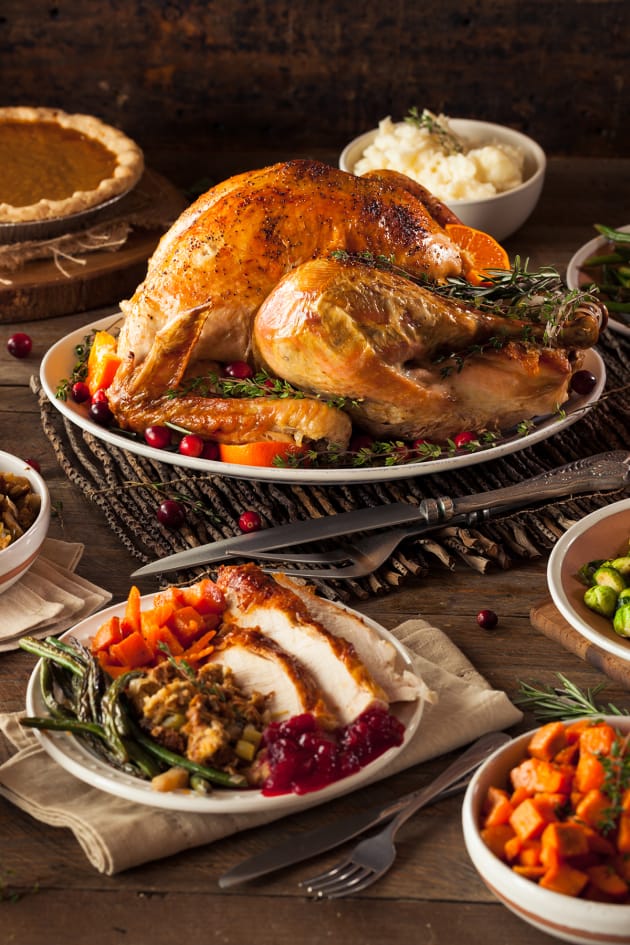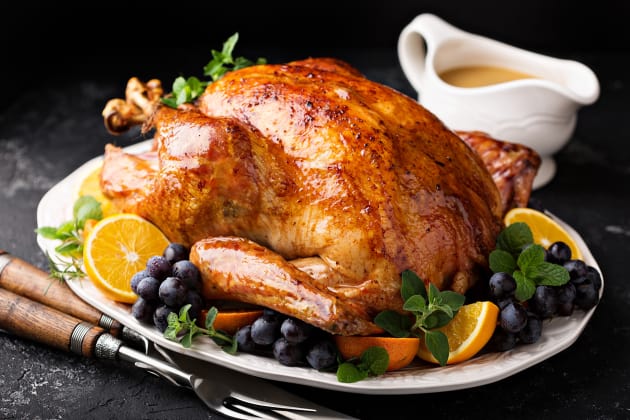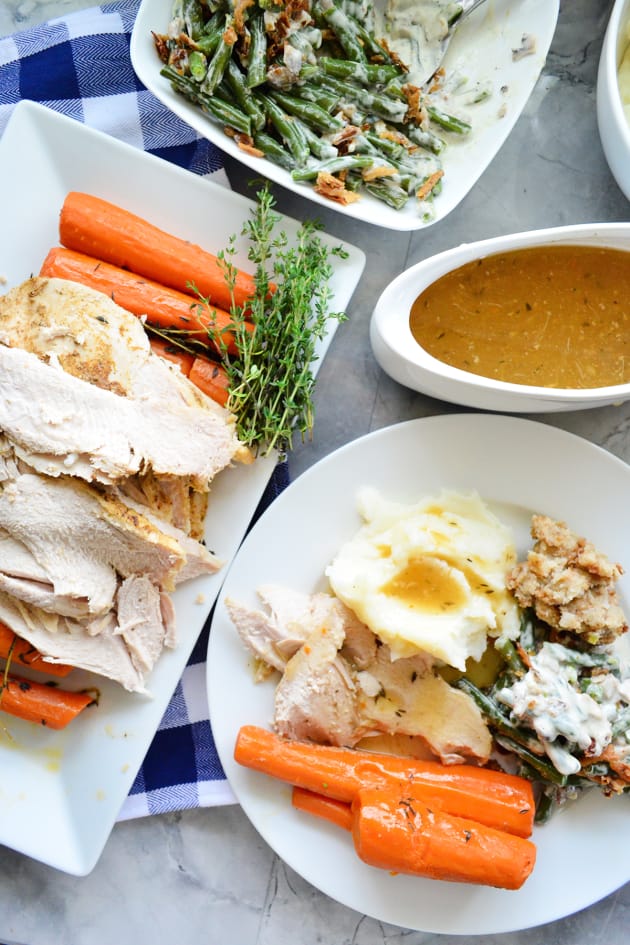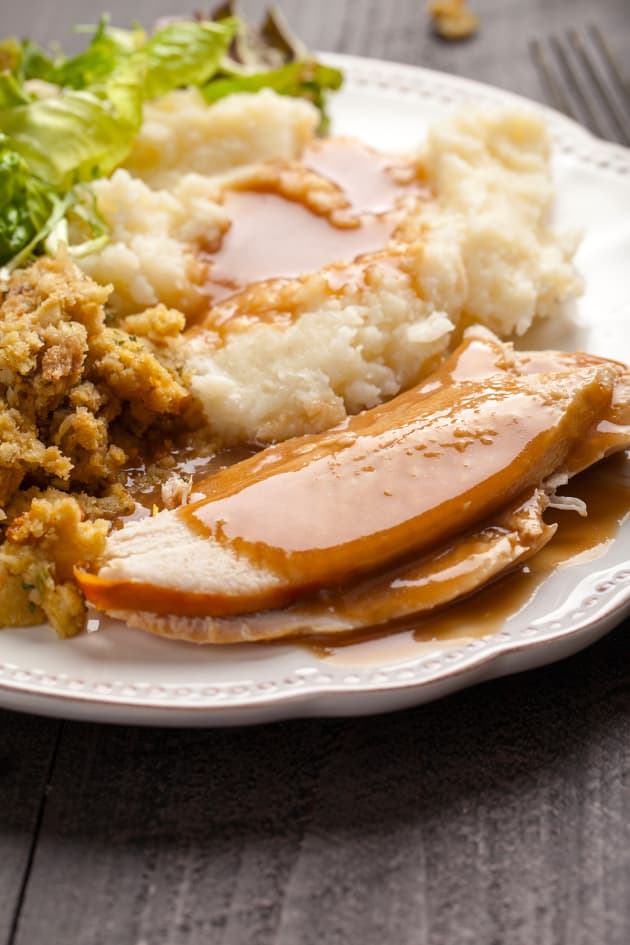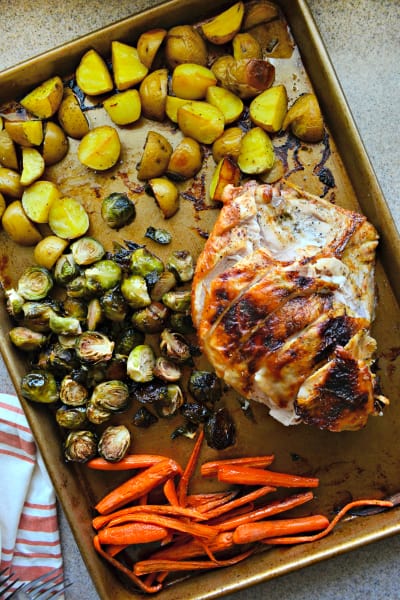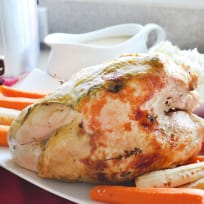Everything You Need to Know About Cooking a Turkey
Nicole AustinCheck out our handy guide to cooking a turkey - our best tips, tricks and guidelines for preparing for the perfect turkey dinner.
Whether you buy a fresh or frozen turkey, you and your guests can enjoy a delicious turkey dinner by following our simple guidelines for cooking a turkey.
We get it, trust us. Cooking a turkey can seem incredibly daunting, especially if you've never done so before, but no worries! We have you covered.
Because many people only prepare a whole turkey on holidays or special occasions, it can be tough to remember from year to year exactly when, how, and for how long you should buy, store, and thaw a turkey.
Here’s a straightforward guide to preparing the perfect turkey whether for Thanksgiving, Christmas or any time of year.
How Far in Advance Should You Buy a Turkey?
Let's tackle the first thing first. How far in advance should you buy a turkey? Well, there are a few considerations to keep in mind.
The question of when to purchase your turkey primarily hinges on one important factor - will you be buying a fresh turkey or a frozen turkey?
If you plan in advance, it's possible that you live in an area where you can order a farm fresh turkey, but doing so often requires planning well in advance.
Otherwise, chances are you're dependent on a grocery store. Most grocery stores keep a majority of their turkeys frozen because they last longer.
That said, many grocery stores do stock fresh turkeys that are not yet frozen during the holiday season, so it's still possible to get a fresh turkey at a store.
If you're buying a fresh turkey, do so 1 to 2 days before the day you will be cooking it - this goes for fresh turkey from the grocery store or a farm.
Should you happen to grab a fresh turkey from the grocery store and there is a 'best-by' or 'use by' date on the packaging, you can store the turkey, unopened, in the refrigerator until that date.
Many people who have the storage space available in their freezers like to buy ahead to avoid any last-minute rush to the store in an attempt to find the perfect turkey for their guest list size.
I recommend planning to buy a frozen turkey for this reason - it gives you the advantage of expecting to need time to thaw the turkey!
That said, if you're buying a frozen turkey, be sure to leave enough time for it to properly thaw, which is can take a few days depending on the size of your bird.
Otherwise, you can buy a frozen turkey as early as you'd like! Raw turkey that is properly packaged in an airtight wrapping can be stored for up to two years, but will taste best within one year.
What Size Turkey Should You Get?
Knowing what size bird and how many pounds of turkey you need for your family and friends can feel a bit tricky, but it's actually a very simple formula.
Generally, the rule of thumb is to plan 1.25 pounds of turkey per person. If you are serving children, you can round down to 1 pound of turkey per kid.
If you want to ensure that you have a good amount of leftover turkey, skew things up and plan for 1.5 to 2 pounds of turkey per person depending on how much you'd like leftover.
That said, it's estimated that average adults tend to consume 1.25 pounds of turkey at Thanksgiving dinner, for general reference or if you want to plan for little to no leftovers.
Fresh vs. Frozen Turkey: What to Know
A lot of people wonder about the difference between fresh vs. frozen turkey, if there is a noticeable difference and if one is actually better than the other.
For quick reference, the USDA refers to “fresh” turkeys as those that are stored at or above 26°F and frozen turkeys as those stored at 0°F or below.
Officially The National Turkey Federation says, "There is no quality difference between a fresh and frozen turkey."
Freezing meat does impact cell structure, and some people feel there is a noticeable difference in the texture of meat that was previously frozen.
While a handful of people may argue that the turkey is drier or tougher than if it had not been frozen, the general consensus is that there is no major difference between the two.
Turkeys labeled as “self-basting” are injected with or marinated in a solution that includes butter or other edible fat, broth, stock, or water, along with spices and approved flavor enhancers.
This increases the moisture content in the meat, which can counter the drier meat you may find, but it also changes the natural flavoring of the meat, which is something to keep in mind.
It is also important to recognize that "fresh" turkeys purchased at the grocery store are not quite the same as turkey purchased fresh from a local farmer.
There can be a noticeable taste difference between grocery store turkeys and a fresh, local turkey because their diets may vary leading to a different taste.
One point of criticism is that fresh turkeys can have a gamey taste and a tougher, drier texture, but largely it just a matter of personal preference.
How to Store Turkey
Knowing how to store a turkey is crucial to safely preparing your next turkey dinner - and again, it all comes down to whether your turkey is fresh or frozen.
Fresh turkey can be stored in a refrigerator at optimal temperatures for food safety. Keeping your fridge at 40 degrees F or below will slow the growth of harmful microbes.
After purchasing meat or other perishables, you should store them in a refrigerator immediately upon returning from the store, farm, or meat market.
Frozen turkey should be stored in a freezer that is kept at or below 0°F. It will remain safe and fresh as long as it has not been thawed and the seal is airtight.
If you're talking about storing leftover turkey, you can safely store leftovers for up to 3 to 4 days when stored shortly after serving in an airtight container.
When to Thaw a Turkey
If you're wondering how to defrost a turkey, the safest way to thaw turkey is by giving yourself plenty of time to slowly thaw the turkey in the refrigerator.
The generally accepted rule of thumb is allow for 24 hours of thawing for every 5 pounds of bird, so you’ll have to do some basic math to plan ahead.
Once thawed, you will need to cook the turkey within 1 or 2 days. This is essential for the safety of the meat for your guests!
It's important to remember that a frozen turkey will often leak a lot of juice as it thaws, so plan ahead and prepare containing for the mess.
Keeping the turkey in its original wrapping and placing it in a shallow tray is your best bet for preventing cross-contamination with the rest of your food.
How to Thaw a Turkey Fast
Maybe you didn’t plan ahead or forget to set a reminder for when to take the turkey out of the freezer and now your turkey is still frozen.
Or maybe your plans fell through to eat elsewhere or you just decided at the last minute that you feel like eating turkey dinner.
Whatever the case may be, it occasionally happens that you have to know how to thaw a turkey fast while still making sure you're doing so safely.
We’ve got your back! But - be sure to follow this step-by-step guide to thawing a turkey fast to avoid food poisoning due to the growth of harmful bacteria.
The best option for fast thawing is the cold water method, a process that can speed up thaw time for a 5 pound turkey from 24 hours to as little as 2.5 hours!
This method is labor intensive and not recommended for people looking for a laid back holiday, but it’s definitely better than not delivering on the big day.
How to Thaw a Turkey in Cold Water
- To thaw a turkey using the cold water method, you will need a large zip-top bag.
- Keep your turkey sealed in the original packaging, place it inside the bag, and seal it.
- Fill your sink with cold water from the tap and place the turkey into the water, breast side down.
- Using a heavy pan or plates, weigh down the turkey to hold it in place, otherwise it will float.
- Set a timer for 30 minutes. Once this timer goes off, replace the water in the sink and repeat this process for another 30 minutes.
- You’ll do this 30 minutes at a time until the turkey has fully thawed.
Important: Do NOT use warm or hot water instead! Even though you correctly assume that hot water will work faster, this is not safe.
The outer meat will thaw much faster than the meat at the center of the bird and will cause food safety issues that can lead to food poisoning.
You can also thaw a turkey in the microwave, but this can cause the same issues as noted above about meat warming up unevenly.
This is not our recommendation, but if you’re in a real bind, it may be your only course of action.
To use the microwave method, follow the instructions of the manufacturer to try to ensure best practice methods for food safety.
This could take an hour or more, so plan ahead accordingly. Be sure to remove any metal clips or fasteners before microwaving your turkey.
You will want to cook your turkey immediately to avoid additional food safety concerns.
How to Brine a Turkey
Brining a turkey will add flavor and make the meat juicy and tender. In fact, learning how to brine a turkey was a total game changer for my turkey reputation.
When we refer to brining a turkey, you can either wet brine or dry brine your turkey. Either way, it's super simple to adjust recipes to find the flavor combination you love best.
Wet Brining a Turkey
Wet brining is the most common method of bringing a turkey and is arguably the simplest way to do so.
Wet brining a turkey involves filling a large container that will hold the entire turkey with a solution of 50:50 salt and water.
The unstuffed turkey is then placed inside and allowed to soak. During this process, an exchange takes place between the water in the turkey and the brining liquid.
Eventually, the salt level of both will be the same resulting in a tastier, more tender turkey. For safety, make sure your brining solution is completely cool.
We recommend boiling up just enough water to dissolve the salt, then using cold water to top up your container to the desired quantity.
You will need to transfer the turkey in the brining solution to the fridge. Brining at room temperature would be unsafe as it could encourage the growth of bacteria.
Make sure you set a timer so you do not brine the turkey for too long. A good guideline is one hour per pound, meaning you would brine a 12-pound turkey for 12 hours.
When in doubt, it’s better to err on the side of less time, if you’re on the fence. A turkey left in a brining solution too long can become mushy and unappealing.
Dry Brining a Turkey
A less common method of brining turkey, known as dry brining, involves rubbing the whole bird with salt, which is also a super easy way of adding flavor to your unstuffed bird.
If you like a turkey with crispy skin, dry brining generally creates a crispier skin after cooking, which some people prefer. Inside you'll still have moist turkey.
An advantage to dry brining is that the turkey does not take up any additional fridge space! This can be really handy if you're planning for a feast with lots of sides and desserts.
Dry brined turkeys will rest in a food safe bag rather than a larger container, which can reduce the room you need to store other prepared sides or fresh fruits and vegetables.
Our Guidelines for Cooking a Turkey
While the pressure of perfecting your Thanksgiving turkey may feel immense, if you follow our rules and guidelines, you can prepare a safe, delicious turkey for your guests.
If you follow our guidelines for how to roast a turkey, you'll find that it's not as tricky as you might think once you've selected and prepared your turkey.
- Remove the thawed turkey from the packaging and remove the giblets from the turkey cavity. Preheat the oven temperature to 350°F.
- Tuck the wing tips by bending them behind its back, which will prevent burning during roasting. Tie the legs together at the ends using some twine or kitchen string.
- Rub the outside of the turkey with butter or olive oil and place it in a shallow roasting pan.
- Even if you have brined your turkey, season again with aromatics and stuff the inside cavity with aromatics of your choice – garlic, fresh herbs and onions always work well.
- Optionally, add chopped vegetables, like carrots, celery and onion to the bottom of your roasting tray, which will add extra flavor to the turkey drippings making for a delicious turkey gravy.
- Place a roasting rack on top of the veggies and then place the turkey onto the rack.
- Roast until the internal temperature of your turkey reads 165° F using a meat thermometer inserted into the thickest part of the thigh; the juices should also be clear. (We suggest an instant-read thermometer as our food thermometer of choice for this job.)
- Once fully cooked, let the turkey rest before carving. In the meantime, use the pan drippings from the bottom of the pan along with melted butter to make a delicious gravy.
- Alternately, considering making a paper bag turkey where the turkey is roasted in parchment paper - the results are delicious!
So, how long does it take to roast a turkey? The simplest calculation is to plan for 13 minutes per pound at 350°F for an unstuffed turkey, translating to about 3 hours for a 12 to 14 pound turkey.
How to Carve a Turkey
Now that you've selected, purchased, thawed, brined and roasted the perfect bird, you may be wondering how to carve a turkey if you've never done so!
Never fear - like most cooking techniques, carving a turkey properly isn't as daunting as you might believe.
- The most important thing is to allow your turkey to rest for 20 minutes to a half hour before carving, allowing the meat to absorb the juices after roasting.
- Place the turkey on a carving board. Cut away and discard the strings from the legs first thing.
- Next, cut away the legs first, then the wings.
- Carve the turkey breast last by first pulling the skin back, exposing the meat.
- Pull one breast away from the center bone, as you insert the point of your knife along the curve of the bone to remove the meat.
- Repeat with the breast on the other side of the bone. With a long slicing knife, slice the meat against the grain (in the opposite direction of the lines of the meat.)
Our Favorite Alternatives to Roasting an Entire Turkey
Maybe after all of this, you're not interested in roasting an entire turkey, or maybe you're cooking for a smaller crowd or don't prefer dark meat.
There are a bunch of reasons why cooking a turkey might not be of interest to you, which is why we have you covered with alternatives to roasting an entire turkey.
Try your hand at making our slow cooker turkey breast recipe - this recipe boasts all of the turkey flavor with little of the effort!
Likewise we love making turkey breast in a pressure cooker like this Instant Pot turkey tenderloin recipe with mushroom gravy.
We also highly recommend this Instant Pot turkey breast recipe with carrots and homemade gravy. It's ready in no time at all!
You can also try our turkey tenderloin recipe made in a heavy bottomed cast iron dutch oven along with stuffing all in one pan.
Finally, our sheet pan turkey breast recipe serves up honey roasted turkey and vegetables all on a single pan and skimping on none of the flavor.
However you decide on cooking a turkey (or a turkey breast) I hope these tips and recipes give you the confidence to give it a try!
Planning a dinner party and need some inspiration?
How about looking for a new slow cooker dinner idea?
We’ve got you covered in our ever-growing Facebook group! If you’re not a member yet, why not?!

We’re chatting cooking techniques, dessert ideas, and everything in between. If you’re already a member, invite your friends to join us too!
Nicole is a self-published author of fiction novels, and a lover of food and spending time in the kitchen with her six children. She lives in coastal Maine where she loves exploring new recipes especially those that can save time, money and wow a crowd.
Tags: Turkey, Thanksgiving, Entertaining, Holidays, Cooking Techniques, Family Meals and Snacks


